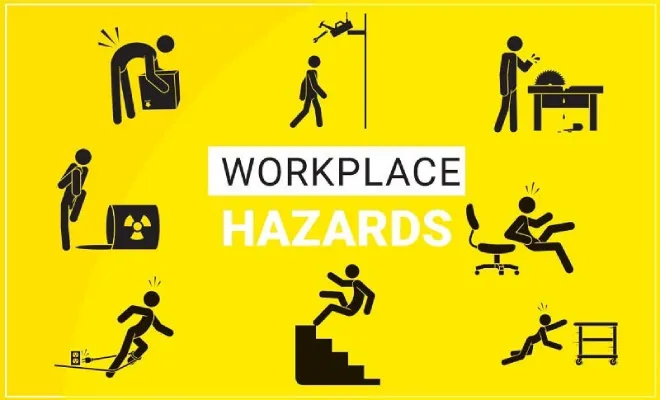Hazard Identification Exercise
Picture this: You’re halfway through a night patrol, walking past a stairwell. A cable is trailing across the floor, and one light is flickering. Do you:
Step over it and carry on?
Or stop, secure the area, and escalate the hazard?
Your decision in that moment could be the difference between an uneventful shift and a serious accident report.
The HSE tells us that slips and trips cause over 30% of major workplace injuries in the UK. That’s not a small number. And under the Health and Safety at Work Act and your SIA duties, you’re expected to act—not ignore.
Tip: Think of every hazard as a test of your vigilance, not just an inconvenience.

Scenario Walkthrough: Spot, Think, Act
Let’s run through a practical hazard identification exercise. Imagine you’re patrolling a shopping centre:
1. Entrance Doors – Rainy Evening
You see water pooling just inside the doors. Shoppers are hurrying in.
What do you do?Option A: Leave it—it’s “cleaners’ responsibility.”
Option B: Place a wet floor sign, alert cleaners, and log it.
Correct: Option B. Even if cleaners mop up later, your quick action prevents slips now.
2. Service Corridor – Cables Across the Walkway
A contractor has left a cable trailing between two sockets.
What’s your move?Option A: Step over it and continue.
Option B: Stop access, contact facilities, and log the hazard.
Correct: Option B. One ignored cable can turn into a compensation claim if someone trips.
3. Stairwell – Faulty Lighting
A bulb is blown, leaving the bottom steps in shadow.
What next?Option A: Use your torch and ignore it.
Option B: Report it immediately and note it in your patrol log.
Correct: Option B. Your torch helps you, but what about the next person?
Tip: Always think: Would a member of the public see this hazard? If the answer is “no,” treat it as urgent.
Hidden or Overlooked Hazards
Not all hazards are obvious—some are easy to miss if you’re rushing.
Uneven flooring: Small cracks or raised edges can catch a shoe.
Obstructions at height: Boxes stacked too high may topple.
Loose handrails: Only spotted when you test them.
Example: On a stairwell check, an officer noticed a wobbly handrail. It hadn’t caused a fall yet, but reporting it prevented a serious accident later.
Tip: Don’t just look—touch and test. Push doors, check handrails, walk mats. Active checks reveal hazards passive observation won’t.
What Happens If You Miss a Hazard?
Missing a hazard isn’t just a small oversight—it can set off a chain reaction with serious consequences:
For the casualty: A wet floor, loose mat, or trailing cable can send someone to hospital with broken bones, head injuries, or worse. What looks “minor” to you could change their life.
For you as an officer: Failing to act may be classed as negligence. That could put your SIA licence, your job, and your professional reputation at risk.
For your employer: One ignored hazard can mean HSE investigations, legal claims, costly fines, and a damaged public image.
Tip: Think of every hazard as a crossroads—you can either prevent an accident or explain afterwards why you didn’t. Prevention is always the safer path.
Learning from Past Incidents
Every accident tells a story. Reviewing past slips, trips, and falls helps you spot patterns and prevent repeat hazards.
Ask: Has this hazard appeared before? (e.g., rain pooling at the same doorway).
Check logs: Patrol reports and accident books highlight recurring risks.
Share lessons: Pass on what you learn to colleagues on shift handovers.
Example: A site had three separate slip incidents at the same staff entrance in one month. After officers raised it as a repeat hazard, facilities installed a canopy and better mats—no further accidents occurred.
Tip: Think like a detective. Every repeated hazard is a clue pointing to a permanent fix.
Real-World Scenario: The Curled Mat at Midnight
It’s half past midnight on your patrol. The building is quiet, and you’re feeling the drag of a long shift. In a rarely used side corridor, you notice a floor mat with its corner curled up. Hardly anyone passes through here—at least, not usually.
You pause. Do you:
Walk on, thinking “no one uses this corridor at night” and save yourself the hassle?
Or stop, log the hazard, raise it with control, and make sure it gets sorted?
Here’s the catch: a cleaner starting their early shift might walk that way in the next hour. If they trip, it won’t just be their injury—it’ll be a formal investigation into why the hazard was ignored.
Tip: A professional officer never relies on “probably safe.” If a hazard exists, assume someone will be affected—because sooner or later, they will.
Key Considerations
Hazard spotting is about priority and action. Some hazards need immediate control (like pooling water), others need reporting and follow-up (like faulty lights).
Never assume “someone else” will act. Your log may be the only record.
Working with cleaners and facilities is part of your role—it’s about teamwork, not blame.
The public rarely see what you prevent—but your employer, supervisors, and regulators certainly notice if you don’t act.
Tip: Make stairwell checks part of your standard patrol rhythm. A 10-second stop to assess lighting can prevent weeks off work.
Every Hazard Is a Decision Point
Each time you spot a hazard—a wet patch, a loose cable, a broken step—you’re standing at a crossroads.
One path is action: you step in, make it safe, report it. That single choice could prevent an injury, protect your site, and show everyone you’re a true professional.
The other path is inaction: you walk past, hoping nothing happens. But if someone trips, it’s not just their injury—it’s your judgment, your SIA licence, and your employer’s reputation on the line.
Hazard spotting isn’t about ticking boxes—it’s about proving, shift after shift, that you can be trusted to make the right call under pressure.
Tip: When faced with a hazard, ask yourself: “If someone gets hurt here later, could I honestly say I did everything I should?” If the answer is “no,” then you already know what to do.

